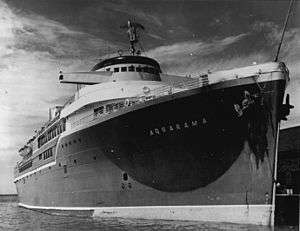SS Aquarama
 The Aquarama docked in Cleveland, 1956. | |
| General characteristics | |
|---|---|
| Type: | Passenger Ship |
| Tonnage: | 12,733 tons |
| Displacement: | 10,600 tons |
| Length: | 520 ft. |
| Beam: | 71 ft. 6 in. |
| Decks: | 9 |
| Installed power: | 10,000 horsepower |
| Speed: | 22 mph |
| Capacity: | 2,500 passengers |
| Crew: | 189 |
The SS Aquarama, formerly known as the SS Marine Star, was a World War II troop ship for the United States Navy. In 1952, it was converted into the largest passenger ship ever to operate in the Great Lakes.[1]
Ship History
Originally named the Marine Star, the Aquarama was built in 1945 in Chester, Pennsylvania as a United States Maritime Commission C4-S-B5 type of ship.[2] Designed as a transoceanic troop carrier, the ship made one trip across the Atlantic before combat ceased.
The ship remained unused for a few years until it was bought in 1952 by the Sand Products Company of Detroit.[3] After being purchased, the ship was towed to Muskegon, Michigan where it was converted into a commercial cruise ship. The entire process took approximately two years to complete and cost nearly $8 million.[1] The president of the Sand Products Company at the time, Max Mckee, wanted the Aquarama to be an ocean liner for the Great Lakes.
The Aquarama began operation in 1956 by touring various Great Lakes ports. In 1957 the Michigan-Ohio Navigation Company, began service from Detroit to Cleveland, carrying automobiles and passengers. Once in service, the ship was able to transport its passengers and their automobiles from Detroit to Cleveland in under six hours.
Although the ship was immensely popular, it never generated enough revenue to be self-supporting; On September 4, 1962 the ship made its last trip before being towed to Muskegon, Michigan. Operating the ship from Muskegon, Michigan to Milwaukee as a replacement for the older Milwaukee Clipper was proposed, but $700,000 for dredging so the Aquarama could be accommodated in Milwaukee harbor was needed. As a result, the ship sat idle until 1987 when it was sold to the North Shore Farming Company for around $3 million.
The Aquarama was briefly docked at Sarnia, then Windsor before returning to its original name of Marine Star and moving under tow to Buffalo. On August 3, 1995 the Marine Star berthed at the Cargill Pool Elevator where it stayed until it was towed overseas to Aliağa, Turkey for scrap in September of 2007.

Capacity and Safety
As a cruise liner, the Aquarama was able to carry 2,500 passengers and 160 automobiles. Some of the ship's safety features included its all-steel construction, the smoke detection system, four 135-passenger lifeboats, the latest in radar, and closed circuit television for viewing the stern.
Entertainment
On the ship there were numerous sources of entertainment for the passengers. Among many other things there was a "carnival room" that had a gift shop, games, and a photo booth. Two television theaters were available to be used for conferences or special programs. Along with the theaters, the ship contained two dance floors that were accompanied by a stage for an orchestra, or other performances. For those traveling with their families, there were even baby-sitting services available. People had the choice of four different types of restaurants that varied in style and price. Along with the restaurants, there was a main cafeteria that was able to fit nearly 300 people.
See also
References
- 1 2 The Aquarama, The Encyclopedia of Cleveland History. 11 Mar. 1998. Web. 4 December 2008.
- ↑ Aquarama-Marine Star, Welcome to Forgotten Buffalo. 2008. Web. 3 December 2008.
- ↑ The Marine Star - AKA The Aquarama, Western New York Heritage Press. 2005. Web. 3 December 2008.